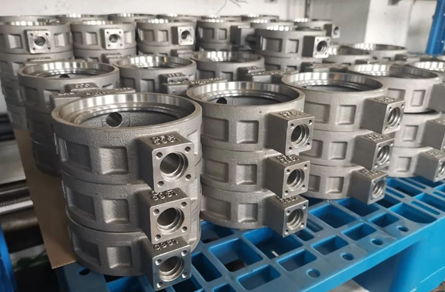- +86 187 3271 1873/+86 132 8322 1383
- [email protected]
The casting is the material in the mold, its stress distribution is uniform, there is no limit on the direction of pressure. The forging is suppressed by the force in the same direction, its internal stress has the directional, can only bear the directional pressure.
1. Casting: it is to melt the metal into a liquid that meets certain requirements and poured into the cast type, after cooling solidification, cleaning treatment to get the predetermined shape, size and performance of the casting (parts or blank) process. This is the basic process of the modern machinery manufacturing industry.
2. Casting blank has low cost, more economical for complex shapes, especially complex cavity; meanwhile, it has wide adaptability and good comprehensive mechanical performance.
3. However, the materials required for casting production (such as metal, wood, fuel, modeling materials, etc.) and equipment (such as metallurgical furnace, mixing machine, sand mixing machine, molding machine, core making machine, sand falling machine, shot blasting machine, casting iron plate, etc.) are more, and will produce dust, harmful gas and noise and pollute the environment.

4. Casting is an early metal thermal processing technology mastered by human beings, which has a history of about 6,000 years. In 3200 BC, copper frog castings appeared in Mesopotamia. Between the 13th BC and the 10th century BC, China had entered the heyday of bronze castings, and reached a quite high level. For example, the Simu Wu Fang Ding weighing 875 kg in the Shang Dynasty, the Yi zun plate of Zeng in the Warring States Period and the light transmission mirror of the Western Han Dynasty are the representative products of ancient casting. Early casting was greatly influenced by pottery. Most of the castings were tools or utensils in agricultural production, religion, life and other aspects, with strong artistic color.
In 513 BC, China cast the first recorded iron cast —— in the state of Jin (about 270 kg weight). Around the 8th century, cast iron production began in Europe. After the Industrial Revolution in the 18th century, castings entered a new period of serving the great industry. In the 20th century, the development of casting is fast, has developed ductile iron, malleable iron, ultra-low carbon stainless steel, aluminum copper, aluminum silicon, aluminum magnesium alloy, titanium based, nickel based alloy and other casting metal materials, and invented a new process of gray casting iron. After the 1950s, new technologies such as wet sand high pressure modeling, chemical hardened sand modeling, core making, negative pressure modeling and other special casting and shot blasting cleaning appeared.
5. There are many kinds of casting, according to the modeling method is divided into:
① ordinary sand casting, including wet sand, dry sand and chemical hardened sand type 3 categories.
② Special casting, according to the modelling material and can be divided into natural mineral sand as the main modeling material of special casting (such as melt casting, mud casting, casting workshop shell casting, negative pressure casting, solid casting, ceramic casting, etc.) and metal as the main casting material of special casting (such as metal casting, pressure casting, continuous casting, low pressure casting, centrifugal casting, etc.) two categories.
6. The casting process usually includes:
① casting (container for liquid metal as solid casting) preparation, According to the materials used, the casting type can be divided into sand, metal, ceramic, mud, graphite, etc., According to the number of use can be divided into disposable, semi-permanent and permanent type, The quality of casting preparation is the main factor affecting the quality of casting;
② Melting and pouring of the cast metal, Casting metal (casting alloy) is mainly composed of cast iron, cast steel and casting non-ferrous alloy;
③ Casting handling and inspection, Casting treatment includes removal of foreign bodies on the core and casting surface, removal of pouring mouth, projections such as shoveling burr and seam, heat treatment, shaping, rust prevention treatment and rough machining.